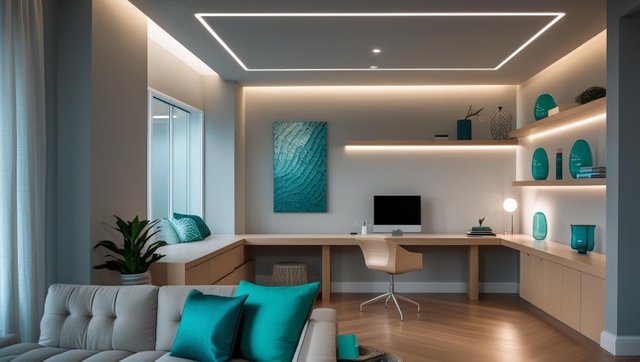The Complete Guide to LED Lighting for Homes and Businesses
In the past decade, LED lighting has revolutionized the way we illuminate our homes and commercial spaces. Once considered a high-end upgrade, light-emitting diode (LED) technology has become mainstream thanks to its energy efficiency, longevity, and environmental benefits. For homeowners and small business owners alike, switching to LED isn’t just about saving on energy bills—it’s about smarter, safer, and more sustainable lighting.
This comprehensive guide covers everything you need to know about LED lighting, including how it works, how it compares to traditional lighting options, and how to implement LED solutions that maximize cost savings and enhance your space.
What Is LED Lighting?
LED stands for “light-emitting diode.” Unlike incandescent or fluorescent lights, which rely on heating filaments or gases, LEDs produce light by passing an electric current through a semiconductor. This process results in:
Higher efficiency (less energy wasted as heat)
Longer lifespan (up to 50,000 hours or more)
More durable components
Cooler operating temperatures
Benefits of Switching to LED Lighting
✅ Energy Efficiency
LEDs use up to 80% less energy than traditional incandescent bulbs and 30–50% less than CFLs (compact fluorescents). That translates to significant savings over time.
✅ Longer Lifespan
Most LED bulbs last 25,000 to 50,000 hours. That’s 10 to 20 times longer than incandescent and 3 to 5 times longer than fluorescents.
✅ Better Light Quality
LEDs offer high CRI (Color Rendering Index) values, providing truer colors and reducing eye strain. They're also available in multiple color temperatures—from warm white to cool daylight.
✅ Eco-Friendly
LEDs contain no mercury, emit less CO2, and reduce landfill waste due to fewer replacements.
✅ Smart Integration
Modern LED fixtures can connect to smart home systems, allowing dimming, scheduling, motion sensing, and even color-changing capabilities.
✅ Reduced Maintenance
In commercial settings like restaurants, retail stores, or offices, fewer bulb replacements reduce labor and downtime.
Types of LED Lighting
💡 Standard Bulbs (A-Series)
Used in table lamps, ceiling fixtures, and common residential settings.
🏢 Panel Lights and Troffers
Flat LED panels for drop ceilings—common in office and retail environments.
🔦 Spotlights and Downlights
Directional lighting used in kitchens, hallways, and display areas.
🌞 Outdoor and Landscape LEDs
Weather-resistant lighting for walkways, signage, or architectural features.
🏠 Integrated LED Fixtures
Modern fixtures that have built-in LEDs, often sleeker and more efficient than bulb-based designs.
Choosing the Right LED Lights
When choosing LED lighting for your home or business, consider the following factors:
- Brightness (Lumens)
Instead of watts, LEDs are rated in lumens. Here’s a general comparison:
Incandescent (watts)
LED Equivalent (lumens)
60W
800 lumens
75W
1100 lumens
100W
1600 lumens
- Color Temperature (Kelvin)
Description
Kelvin (K)
Best Use
Warm White
2700–3000K
Living rooms, bedrooms
Neutral White
3500–4100K
Kitchens, offices
Daylight
5000–6500K
Garages, retail stores, task areas
- Dimmability
Not all LEDs are dimmable. Choose products labeled as such and pair them with compatible dimmers.
- Beam Angle
Wide-angle beams are best for ambient lighting; narrow beams are ideal for spotlighting or task areas.
- Fixture Compatibility
Check your current fixtures for compatibility with LED retrofits or consider upgrading to integrated fixtures.
LED Lighting in Residential vs. Commercial Settings
🏠 Home Applications
Ceiling fans
Recessed can lights
Bathroom vanity fixtures
Accent lighting in cabinets and stairways
Outdoor motion lights
🏢 Business Applications
Linear office lighting
Display case lighting for retail
Security and parking lot lighting
Warehouse and industrial fixtures
Restaurant ambiance lighting
LEDs improve both the utility and aesthetics of professional spaces while reducing overhead.
Understanding Rebates and Incentives
Many utilities and government agencies offer rebates for upgrading to LED systems, especially in commercial applications. These programs can reduce upfront costs by 10–30% or more.
Check with your local utility or an experienced electrical contractor to see what you qualify for. Reputable providers like Integrity Electric, Inc. often help clients navigate incentive programs and product eligibility.
Common Myths About LED Lighting
❌ LEDs are too expensive
Upfront costs have dropped dramatically in the last five years. In many cases, payback on energy savings occurs within 6–12 months.
❌ LEDs can’t produce warm light
Modern LEDs come in a wide range of temperatures, including warm hues similar to incandescent bulbs.
❌ They don’t work with dimmers
Many LEDs are dimmable—you just need the right bulb and dimmer pairing.
Installation and Safety Tips
Always turn off power before replacing fixtures
Avoid mixing LEDs with other bulb types on the same circuit
Use LEDs rated for enclosed fixtures when required
Consider whole-building LED retrofits for maximum impact
For complex installations or large-scale upgrades, working with a licensed electrician ensures safety, code compliance, and proper configuration.
Final Thoughts
Whether you're retrofitting your home or overhauling the lighting in your business, LED solutions offer undeniable advantages in cost, performance, and sustainability. With an expanding range of styles, features, and smart integrations, LED lighting represents the future of indoor and outdoor illumination.
Choosing the right products and installation strategy can deliver long-term returns and a better quality of life. Consult a knowledgeable electrician to help you design a lighting plan that meets your specific needs and enhances your space.
